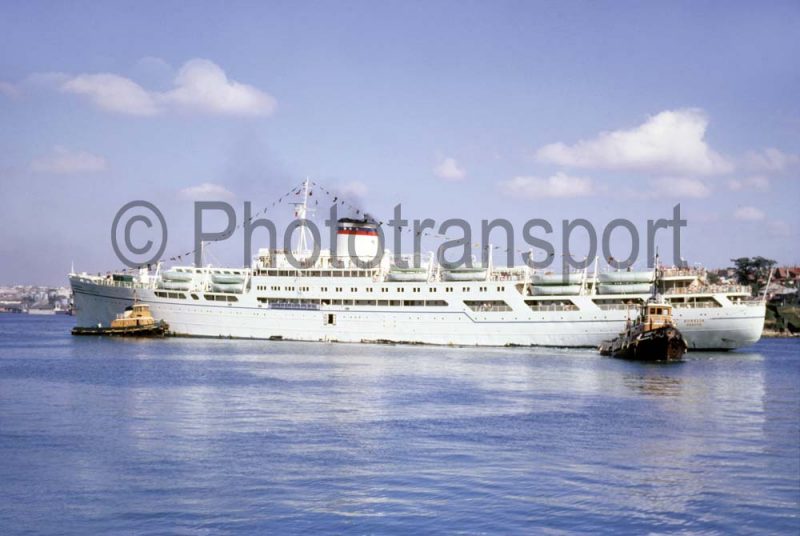
In the aftermath of World War II there was a further surge in emigration from Europe. Although the United States remained a key destination, the focus had shifted significantly to also include South America and the Antipodes. Established shipping lines found themselves in competition with new privateers, companies seeking a share of this expanding, lucrative market.
One such interloper was Cogedar Line (early adverts refer to Congar Line), an acronym formed from the Italian corporate name Compagnia Genovese d’Armamento. Although synonymous with their subsequent service to Australia, the company’s origins were in the La Planta service to South America. Founded in 1946, Cogedar initially managed the steamships Philippa, Enterprise and Mary Louise before securing funds to purchase the 26 year old Capitaine Potie in May 1948, a vessel with an interesting and varied history.
Ordered by the American-Hawaii Steam Ship Company as the 7,899 ton Missourian, she had been launched on 14th December 1921, sliding down the ways at Merchant Shipbuilding Corporation yard at Chester Pennsylvania. Like the Danish motor ships of the era, Missourian’s key distinction was not having a conventional funnel, exhausts were emitted from two short masts housed on the aft superstructure.
Completed the following year Missourian originally operated on the company’s service from the US west coast to Europe, later switching to New York as her western terminus. With the advent of World War II, she was acquired by the British Government in 1940, renamed Empire Swan and managed by Runcunion Ltd. Two years later she was transferred to the Belgian Government in exile, becoming Belgian Freighter and managed by the Compagnie Maritime Belge SA, who subsequently purchased her. In 1946 the same owner renamed the ship Capitaine Potie, oscillating between the colonial link to central Africa and the growing South America trade.
In May 1948 Cogedar purchased the twenty six year old ship and named her Genova, sending their new acquisition to Monfalcone for rebuilding. When Genova emerged the following year the most obvious change was the installation of a conventional, if diminutive funnel, bearing the company’s distinctive livery of a white background, broad blue and red bands embellished with three gold stars. The superstructure had been extended but the majority of work had involved converting her interiors to provide rudimentary accommodation for 860 third class passengers. Genova was a notoriously poor sea boat and the austere dormitory style sleeping quarters were transformed into cargo holds at Buenos Aires, before loading Argentine produce for the northbound voyage. Nevertheless she introduced the sound qualities for which the line became known, cleanliness, good food and a friendly, efficient atmosphere. Genova and her fleet mates were always regarded as happy ships.
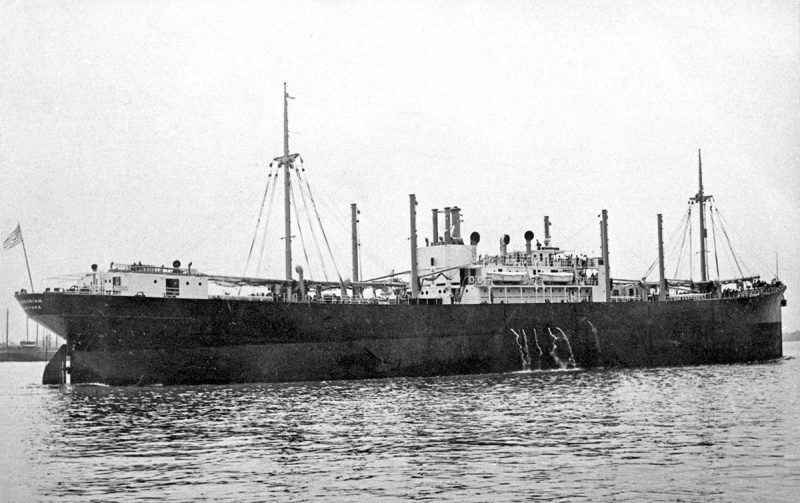
For the next five years Genova sailed to South America, steadily accumulating profits for her owners. By 1954 however there was increased competition on the La Plata service and as rivals introduced new tonnage Cogedar’s board reconsidered its options. They decided to enter the Australia service which although dominated by incumbent Lloyd Triestino and P&O, needed greater capacity. Other new lines were emerging to meet demand, including fellow Italians Sitmar and Star Lauro, lured by the Australian Government’s subsidised passage schemes.
Genova was sent once more to Monfalcone for further rebuilding and improvements. The superstructure was expanded again, with additional public rooms and facilities, including a swimming pool fitted. Perhaps the most important changes were effected in the engine room where new Sulzer diesels replaced the ship’s original propulsion machinery.
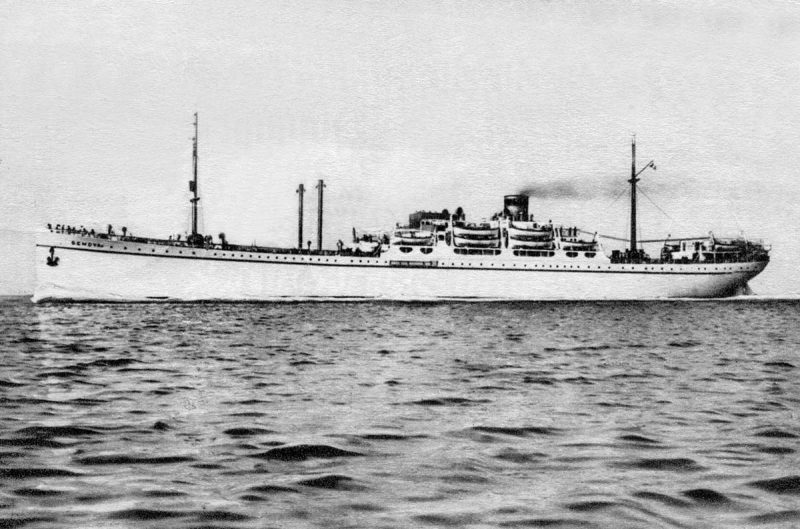
Whilst the erstwhile Genova, now renamed Flaminia, was still being transformed she was joined at Monfalcone by a new fleet mate. To provide a balanced service, due to the extra voyage duration, Cogedar needed a two ship operation. Their new acquisition was given the name Aurelia and like Flaminia was a vessel with a rich and colourful past. Launched on 15th December 1938 and completed just four months later, MS Huascaran was a 6,951 ton cargo liner completed for Hamburg-America Lines’ service between Germany and the west coast of South America. With just 58 passengers accommodated in a central superstructure Huascaran was heavily reliant on her considerable cargo capacity, operating with her sister Orsona until the advent of war. Commandeered by the Kreigsmarine in 1940 she spent the conflict as a U-boat depot and repair ship, primarily stationed in Norway.
In April 1945 Huascaran was captured intact and taken to Liverpool. After an inspection and brief refit she sailed two months later for Montreal having been awarded by the reparations committee to the Canadian Government. With her passenger accommodation redundant Huascaran spent the next two years as a freighter in transatlantic service under the management of Park Steamship Company. On 2 September 1947 she was sold to Canadian Pacific and sent to Sorel, Quebec, for rebuilding as an emigrant carrier. Seventy four passengers were housed in the relative comfort of the superstructure cabins whilst 699 were crammed into the hull. On 8th February 1948 she set out from St Johns, New Brunswick on her maiden voyage to London Tilbury.
Rechristened Beaverbrae, CPs new acquisition sailed on this and all subsequent eastbound crossing as a freighter. At the eastern terminus, generally Bremerhaven, the holds were transformed into two dormitories, before taking on the ‘human cargo’ for the westbound voyage. For more than 6 years Beaverbrae maintained this year round service, ferrying thousands of Europeans to new lives in Canada, returning with timber, meats and other produce from the new world. Sailing from Bremerhaven on 28th July 1954 she undertook her last west-bound crossing, then having disembarked a final consignment of emigrants was laid up at St Johns.
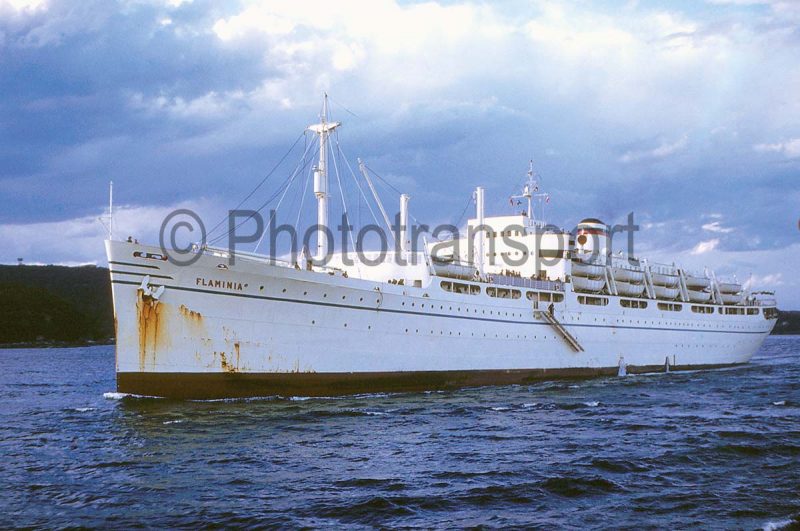
Three months later on 1st November 1954 Cogedar purchased Beaverbrae, renamed her Aurelia and sent her to Monfalcone for rebuilding. As Aurelia started her transformation, Flaminia was nearing completion. In April 1955 Flaminia sailed out of Trieste on an elongated maiden voyage to Cairns.
Just one month later with an extended superstructure, lido and outdoor swimming pool, Aurelia also cast off for Sydney. Air conditioned throughout and refitted in a fresh bright style, the 10,480 grt vessel could accommodate 1,124 passengers in 2 to 8 berth cabins.
The voyage from Europe to Australia was markedly different from the relatively short Atlantic crossings, with a month at sea. Although this allowed time to adapt to the climatic changes it also created a cultural limbo, a somewhat unreal environment between the homeland departed and the new life to be forged. Language and cultural classes were offered to help emigrants adapt to this newly ‘Promised Land’ but inevitably nothing could fully prepare them for the trials and opportunities ahead. Following those initial voyages from Trieste (due to the close proximity of Monfalcone on the Adriatic coast) Flaminia and Aurelia settled into a regular service offering round voyages from Genoa with calls at Naples, Messina, Malta, Piraeus, Port Said, Aden, Fremantle, Adelaide and Melbourne.
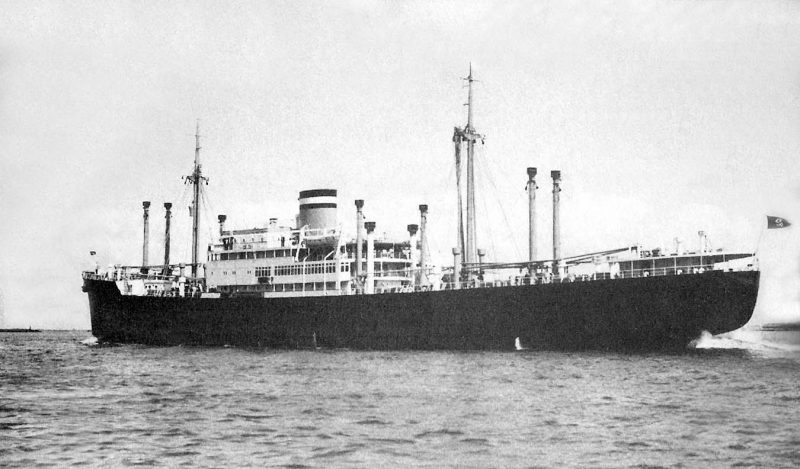
Cogedar retained a high level of popularity as the decade progressed, with increased profitability. Over the winter of 1958-59 Aurelia received a major refit and modifications. The sports deck was extended forward, creating a sheltered, glass enclosed solarium and children’s swimming pool. The company also took the opportunity to replace the twenty year old diesel engines. At this time they also changed schedules by shifting its European operations north. The ageing Flaminia inaugurated the revised service with a sailing on 15th December 1958 departing from Bremerhaven, Rotterdam and Southampton.
Cogedar’s sources of income diversified further at the start of the 1960s. Flaminia was periodically chartered to the Australian Government as a troop transport, whilst in mid-summer of 1960 her fleet mate Aurelia undertook a transatlantic crossing from Bremerhaven to New York on behalf of the Council of Student Travel, which subsequently became an annual fixture.
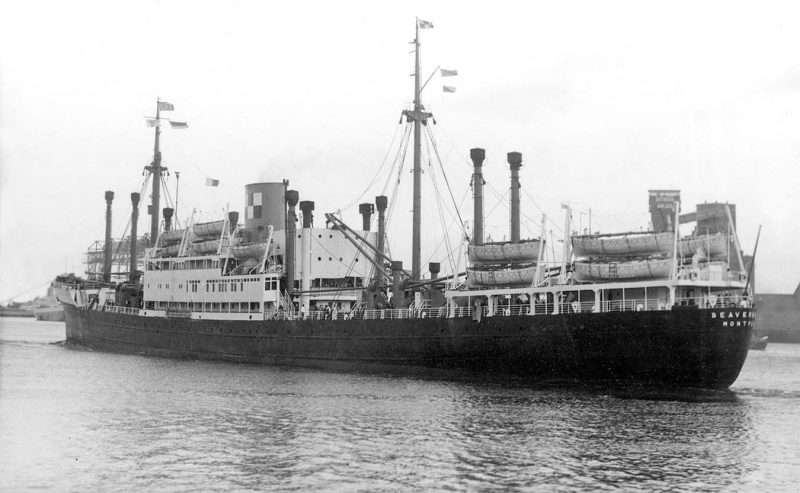
As the Aussie soldier’s testimony bore witness, Flaminia was by now showing her 40 years of service. Although she was repaired after suffering a fire off the Italian coast, she only made one subsequent emigrant voyage, departing Fremantle for the last time on 22nd November 1961. She was chartered to the Israeli Zim Lines for intra-Mediterranean service between Marseille and Haifa. In 1963 Cogedar finally sold their veteran liner to Covena Spa who disposed of her the following year to Saudi Lines. Bearing yet another new name, King Abdeloziz, she entered the Jeddah pilgrim trade. After an extended period laid up in the Saudi port the former Flaminia finally succumbed to the cutters torch at Kaohsuing in 1970.
Flaminia’s withdrawal was prompted by Cogedar’s decision to buy a replacement. Their choice was the 14 year old Cunard cargo-liner Media, renowned as the first transatlantic liner to be fitted with fin stabilisers, an ideal candidate considering her notorious reputation as an extreme ‘roller’. Media was purchased by Cogedar Line for £740,000 in July 1961 but continued in service until handed over at Liverpool on 12th October 1961.
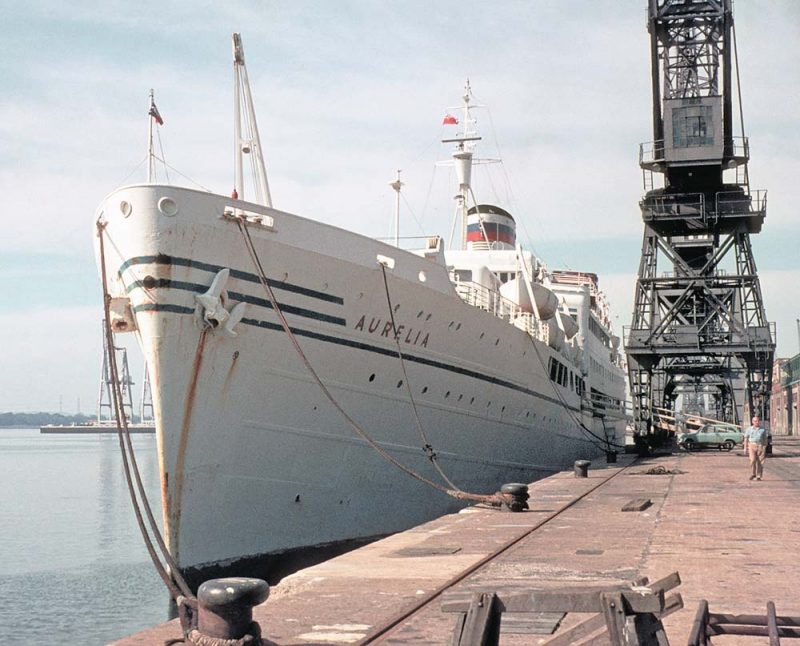
Media and her identical sister ship Parthia were Cunard’s first new builds after the Second World War, they were also the company’s only combination-liners. Originally conceived as 12 passenger freighters for the associated Brocklebank Line, at an early stage plans were revised and instead they emerged as parent company vessels. Media was launched at the famous at John Brown & Co. yard into the chill waters of the Clyde on 12th December 1946 having been named by Mrs Alfred Barnes, wife of the incumbent Minister of Transport. At 13.345 gross tons and 161.84 metres long she was designed to operate a protracted transatlantic schedule from Liverpool to New York, an intimate ’clubby’ experience for 250 pampered First Class passengers.
As with many contemporaries, freight capacity was a key component of the new design and Media’s 6 cargo holds were worked by an assortment of derricks, grouped in clusters around the prominent forward mast and three sets of king posts. On 20th August 1947, following successful sea trials in the Firth of Clyde and a week after arriving in the Mersey, Media departed on her maiden voyage. Her pleasingly balanced profile, with black hull, white superstructure, buff masts and cargo gear, plus ubiquitous central Cunard funnel stood out against the magnificent Liverpool waterfront, which included the company’s headquarter offices and adjacent Liver building.
At first Media and Parthia were successful and attracted a loyal following. They established a well-reputed service, fondly remembered by those who eschewed the more impersonal express service of the Southampton based ‘Queens’ and Mauretania. In fact the ships were inherently costly to run and by the late 1950s Cunard were looking to invest in a new, more efficient and profitable fleet of freighters. Following the withdrawal from service of the last White Star ship, Britannic, which had shared the Liverpool-New York run with the cargo liners, Sylvania, one of the Saxonia class, originally designed for the Liverpool-Montreal service, was transferred as a replacement in April 1961. Soon it became apparent that Sylvania was able to meet the demand for all Liverpool-New York traffic, so Media and Parthia were promptly put on the sales list.

They soon found buyers. Media was acquired by Cogedar Line for £740,000 in July 1961 and handed over at Liverpool on 12th October 1961. Nine days later she arrived at Genoa for a 12 month transformation. What emerged from the OARN yard at the end of September 1962 was effectively a new vessel, certainly unrecognisable from her previous Cunard incarnation. As a passenger liner the new Flavia featured a contemporary profile with a single mast above the bridge and a stylish ovoid white funnel. This featured a prominent soot shield and displayed Cogedar’s distinctive colours. A solitary cargo hatch forward was serviced by a neatly sculpted pair of kingposts and associated booms. Dimensionally her gross tonnage had increased to 15,465 but even more significantly her length was increased by 26 feet. It was arguably the most dramatic and successful conversion of its day.
Flavia had eight decks, offering accommodation for 1,320 Tourist Class passengers. Being a one class ship afforded several advantages, most notably the requirement for just a single set of public rooms. Without doubt the most impressive of these was the two deck high Riviera Lounge, with its capacious lower level featuring a large dance floor, comfortable modern seating and a corner bar. Supported by slender columns was an encircling gallery and intricate balustrade. The interiors were entrusted to a single designer, Matteo Longoni, who having graduated from Milan Polytechnic had been instrumental in the revitalisation of Italian Line’s post war services. Commissions included elements of the rebuilt Conte Grande and Conte Biancamano, as well as Cabin Class accommodation on Giulio Cesare, Andrea Doria and Cristoforo Colombo. He started work on Flavia shortly after completing the Veranda’s, Lido and swimming pools of Leonardo da Vinci.
Flavia’s success stemmed in part from the relative simplicity of Longoni’s design which was comfortable, co-ordinated, yet fresh and light. The Riviera Lounge may have been the grandest example but the dining room, large card room and cinema were further evidence of this philosophy. Cabins reflected the migrant trade for which she had been rebuilt, with 153 two berth, 220 four berth and 5 eight berth rooms. These were significantly more spacious and better equipped than those found on her predecessor Flaminia, including private bathroom facilities for almost all passengers.
Given the extreme modifications perhaps surprisingly the one change which was not implemented was the power plant. The decision to retain Media’s two sets of double reduction geared turbines was no doubt made after evaluating the alternative option, replacing them with more fuel efficient diesels.
On 2nd October 1962, shimmering in the autumn sunlight and dressed overall, Flavia departed Genoa on her maiden voyage to Sydney. On her return from Australia via Suez, Flavia continued north to Bremerhaven, her new European terminus.
Flavia quickly gained an enviable reputation. Like her predecessors she was renowned for her cleanliness, excellent food and general bonhomie. Entertainment was charmingly innocent, traditional shipboard fair included deck sports, cards, ‘horse racing’ and fancy dress. Three swimming pools were provided, a large one on deck with waterslide and extensive lido area and one especially and exclusively for children in a wind protected stadium area forward. Indeed Cogedar diverted considerable resources and deck space to keeping the little ones entertained. In the evening post dinner dancing to the ship’s band was a favourite pastime. With a 17 knot service speed she could not compete with express liners like Canberra and Oriana, or Lloyd Triestino’s new twins Giuglielmo Marconi and Galileo Galilei. Nevertheless she was very popular with emigrants.
In late 1963 COGEDAR introduced a revised ‘around-the-world’ service. Still sailing from Bremerhaven to Rotterdam and Tilbury, Flavia now crossed the Atlantic bound for the Panama Canal. From Panama she steamed south west to Papeete, capital of exotic Tahiti before making her first antipodean landfall at Auckland. After crossing to Sydney she called at Melbourne and Fremantle before returning to Bremerhaven via Suez, Genoa, Tilbury and Rotterdam. This westward circumnavigation was in marked contrast to the predominantly eastward routing of rival lines. From December 1964 Aurelia made three around-the-world voyages before reverting to her Suez based routing.
Competition from the jets had not yet decimated the Australian liner trade the way it had on the Atlantic. It was, nevertheless, only a matter of time. More immediately, Sitmar, Chandris and Star Lauro were introducing new tonnage offering fresh competition for the steadily shrinking migrant trade. Flavia was increasingly employed on cruises from Sydney to Japan and the Pacific Rim.
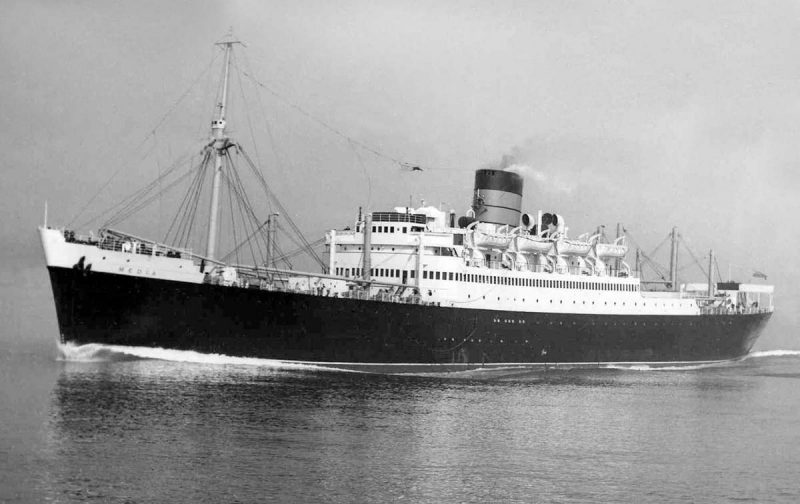
The coup de gras came in June 1967 when the Arab-Israeli conflict led to the closure of the Suez Canal. Re-routing the homeward leg of the liner voyages via Cape Town increased time and expenditure, erasing the last vestiges of profitability. Cogedar closed down its liner operation with the 29th October 1968 departure of Aurelia from Sydney.
On her return to Genoa Aurelia was refitted as a 470 capacity cruise ship but with cost and timing overruns the first such voyage only departed Southampton for Madeira on 5th February 1969. Bookings were poor for the scheduled programme and it was soon abandoned. Fortunately it didn’t really matter as she resorted once more to a three month charter for transatlantic crossings on behalf of the Council on International Educational Exchange. By the time of her last nine day voyage from New York to Southampton, departing on 9th September 1969 she had been sold to another Australian migrant carrier, the Greek owned Chandris Lines. In fact the subsequent refit was not intended to prepare her for liner voyages, instead her new owner was configuring the ship for a cruising role, based primarily in the Mediterranean, as Romanza. From her first cruise, departing Venice on 1st April 1971, until her sale in 1991 Romanza proved to be a solidly reliable vessel. Sailing for Chandris or under charter to various tour operators and a spell with Lloyd Brasilia she cruised the Med, the Indian Ocean (from South Africa) and South American waters. Following a succession of failed owners, Romantica, as the ship was now known, was taken over by Paradise Cruises operating from Cyprus. On the early morning of 4th October 1997 the 58 year old vessel was consumed by a fire which started in the engine room just 60 miles from Limassol. Thanks to a co-ordinated rescue effort, including her former fleet mate The Victoria and British military helicopters there were no fatalities. Alas the former Aurelia was not so fortunate and the burnt out hulk was towed to Egypt for scrapping in April 1998.
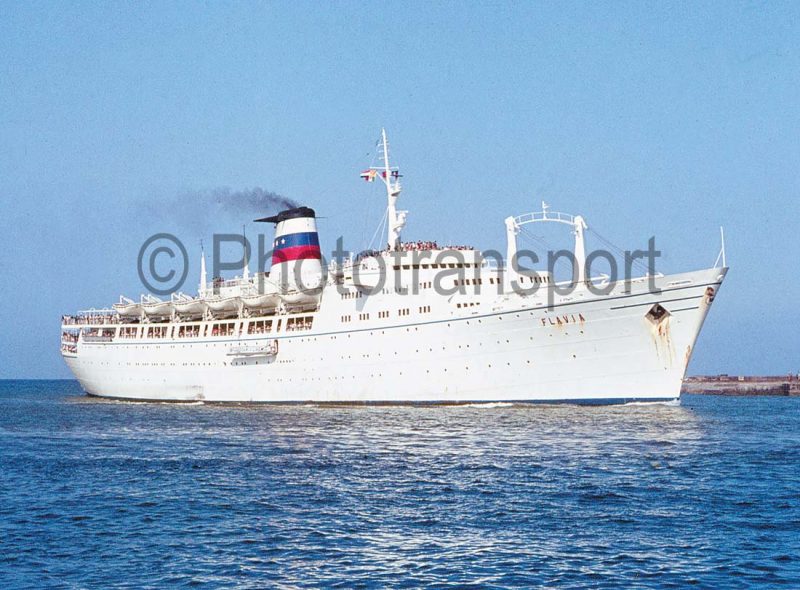
Flavia also made her last voyage to Australia and back in the autumn of 1968. Cogedar Line initially retained ownership of the vessel but chartered her to compatriot Costa Line. She was given a brief refit at Genoa transforming her from liner to cruise ship by upgrading public rooms and withdrawing the use of those cabins without ensuite facilities. Capacity was thereby reduced to 850 passengers.
Sporting Costa’s yellow funnel with its prominent blue C and punctuation marks but retaining her name, Flavia then crossed the Atlantic to take up station from a new home port of Miami, her base of Caribbean voyages.
On 20th December 1968, she sailed on her maiden cruise from the Florida port. Passenger loads and advanced bookings were so impressive that Costa promptly offered to buy the ship with ownership transferred on 1st May 1969.
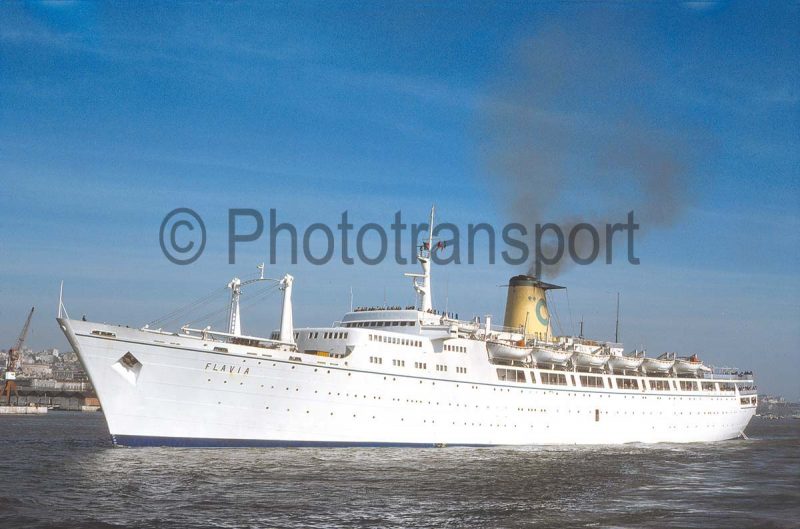
Throughout the following decade Flavia continued to earn substantial profits for Costa on the three and four day cruise circuit to the Bahamas. Sailing to Nassau and Freeport she was instrumental in expanding the Caribbean cruise trade and in particular the significance of Miami as a terminal port. Ironically this development thrived on a partnership with the airlines, the pariahs of the ocean liner trade.
By the mid to late 1970s she was starting to find competition from new upstarts Carnival Cruise Line and Royal Caribbean Cruise Lines. In July 1977, Flavia was repositioned to operate cruises around South American waters and then the following year spent a summer season in the Mediterranean. During this spell she sailed on a seven day circuit from Venice, calling at Dubrovnik in Yugoslavia, Corfu and Piraeus for tours to Athens.
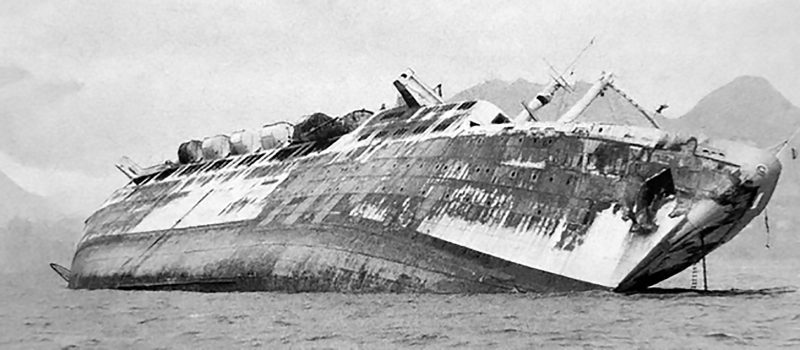
The move was prompted partly from a desire to trial new markets but also Costa’s short lived involvement in Italian Cruises International. Costa therefore replaced the diminutive Flavia with the 33,000 ton former Italian Lie flagship Leonardo da Vinci. Doubtless beautiful and grand Leonardo da Vinci was simply too large and costly to operate.
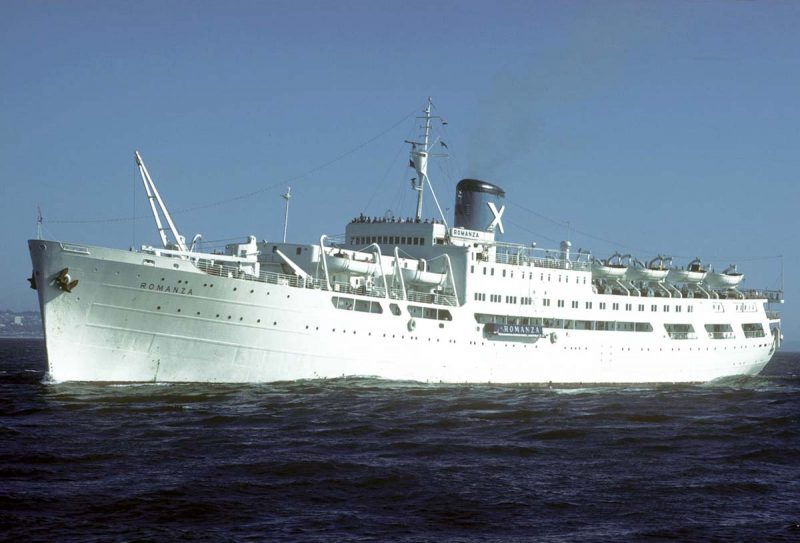
Costa management ruefully complained that their new chartered acquisition burned more fuel at the dockside than Flavia did running at her 17 knot service speed. Costa pulled out of the Italian Cruises International venture in 1978 and Flavia reverted to her Caribbean itinerary.
She was laid up whilst the costs of re-engining were evaluated and considered. Unsurprisingly given that she was now over 30 years old Costa decided it was uneconomical to install diesels and so she was placed on the sales list.
A ready buyer was quickly found. The magnate C. Y. Tung’s Shipping Group purchased the idle vessel and she was handed over to the new owners at Jacksonville on 24th February 1982. Apart from a minor name amendment, to Flavian and painting out Costa colours on her now plain funnel, little was changed. By the end of October 1982, she was anchored in Hong Kong harbour re-assigned to Flavian Shipping SA of Panama but with little evidence of work to re-activate her.
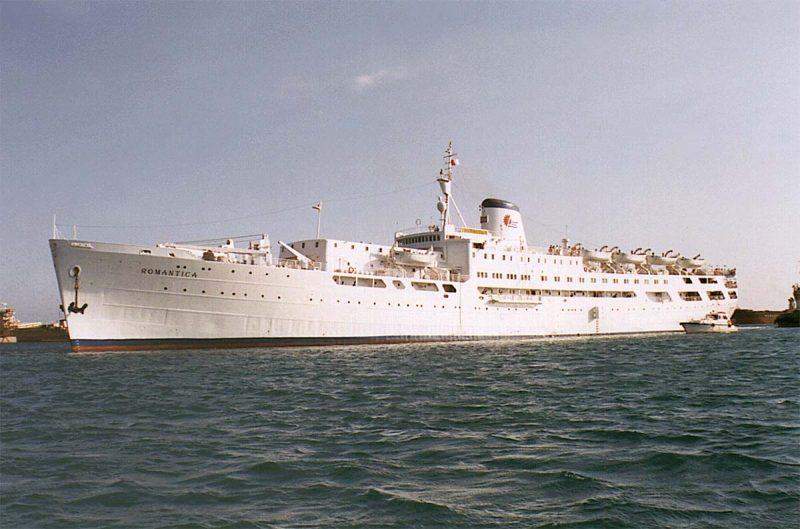
Rust streaked and silent, the sorry atmosphere of neglect surrounding the ship was compounded on 31st May 1984 when the Greek freighter North Marchioness struck Flavian’s port bow and bridge wing. In 1986 she was renamed Lavia as ownership was transferred to the clearly related Lavia Shipping SA, also of Panama. Two years on and almost seven since she last sailed, work began on refitting Lavia for a return to cruise service. It was not to be.
On 7th January 1989, whilst laying at anchor with attendant barges, fire broke out aboard. With an insufficiently trained crew and ineffective equipment the blaze rapidly swept from stem to stern. A line was put aboard and the Lavia towed out of the immediate port area where she continued to burn, plumes of acrid smoke billowing from the smouldering ship which ultimately sank in the shallow waters, resting on her port flank. In the late spring she was righted and then re-floated. Clearly beyond repair, she was unceremoniously towed to Kaoshiung in nearby Taiwan where scrapping commenced in June.
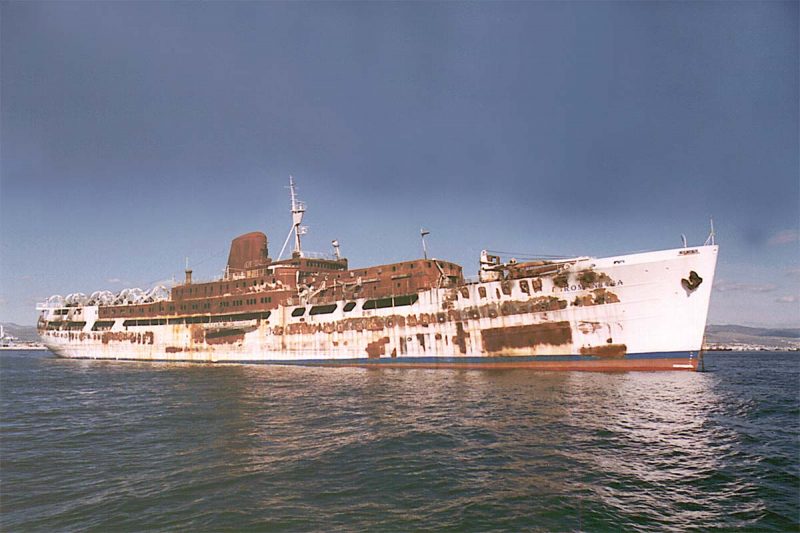

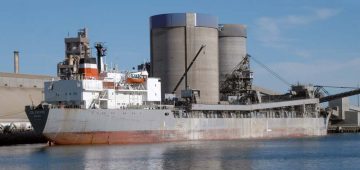



Comments
Sorry, comments are closed for this item